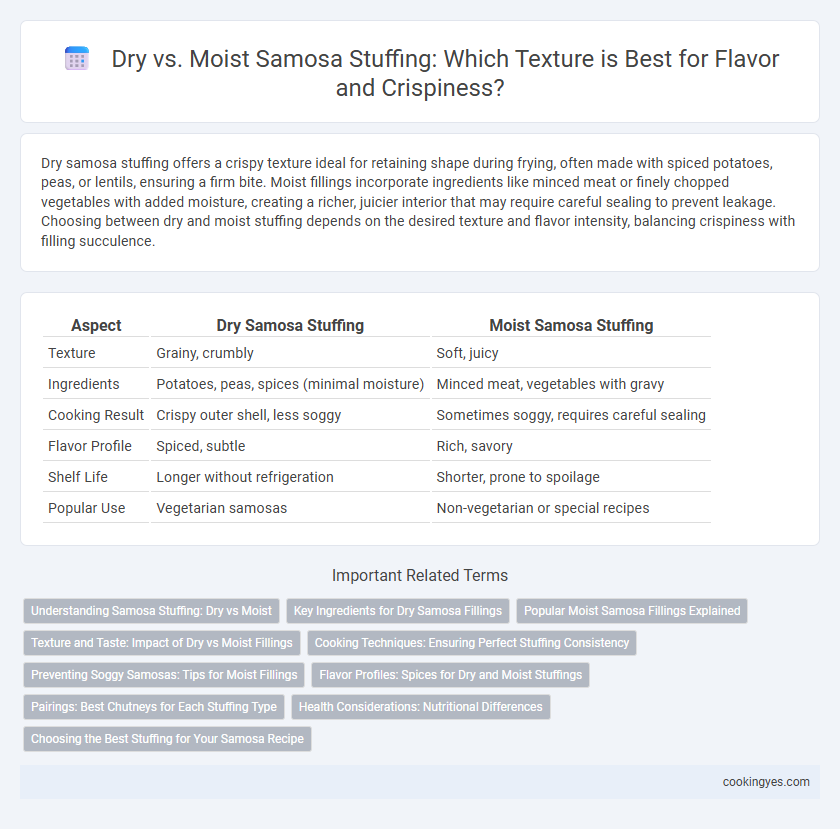Dry samosa stuffing offers a crispy texture ideal for retaining shape during frying, often made with spiced potatoes, peas, or lentils, ensuring a firm bite. Moist fillings incorporate ingredients like minced meat or finely chopped vegetables with added moisture, creating a richer, juicier interior that may require careful sealing to prevent leakage. Choosing between dry and moist stuffing depends on the desired texture and flavor intensity, balancing crispiness with filling succulence.
Table of Comparison
| Aspect | Dry Samosa Stuffing | Moist Samosa Stuffing |
|---|---|---|
| Texture | Grainy, crumbly | Soft, juicy |
| Ingredients | Potatoes, peas, spices (minimal moisture) | Minced meat, vegetables with gravy |
| Cooking Result | Crispy outer shell, less soggy | Sometimes soggy, requires careful sealing |
| Flavor Profile | Spiced, subtle | Rich, savory |
| Shelf Life | Longer without refrigeration | Shorter, prone to spoilage |
| Popular Use | Vegetarian samosas | Non-vegetarian or special recipes |
Understanding Samosa Stuffing: Dry vs Moist
Samosa stuffing varies widely between dry and moist textures, influencing both flavor absorption and structural integrity during frying. Dry stuffing typically includes spiced potatoes, peas, and nuts without much liquid, ensuring a crisp outer layer and preventing sogginess. Moist stuffing often contains ingredients like minced meat or vegetables cooked with sauces, which enhance richness but require careful sealing to avoid leakage and maintain shape.
Key Ingredients for Dry Samosa Fillings
Dry samosa fillings typically include key ingredients such as boiled and mashed potatoes, green peas, roasted peanuts, and finely chopped onions, all seasoned with cumin seeds, turmeric, garam masala, and red chili powder for enhanced flavor. These ingredients are cooked until moisture evaporates, ensuring a crumbly texture that prevents sogginess and maintains the samosa's crispiness after frying. Incorporating dry roasted spices and fresh coriander leaves further elevates the aromatic profile while keeping the filling sufficiently dry.
Popular Moist Samosa Fillings Explained
Popular moist samosa fillings often include spiced potatoes mixed with peas, lentils, or minced meat, creating a juicy texture that contrasts with the crispy pastry exterior. Ingredients like cooked ground lamb or chicken combined with onions, ginger, garlic, and aromatic spices produce a succulent filling that retains moisture during frying. These moist fillings enhance the overall flavor experience while preventing dryness, making them a favorite choice in many regional samosa recipes.
Texture and Taste: Impact of Dry vs Moist Fillings
Dry samosa fillings, such as spiced potatoes or minced meat with minimal oil, create a crisp outer shell that enhances the flaky texture and prevents sogginess. Moist fillings, often containing peas, paneer, or lentils with added moisture or gravy, result in a softer interior, intensifying the taste but requiring careful sealing to avoid leaking during frying. The texture contrast between dry and moist stuffing significantly affects the overall eating experience, balancing crispness with flavorful juiciness.
Cooking Techniques: Ensuring Perfect Stuffing Consistency
Achieving ideal samosa stuffing consistency relies heavily on cooking techniques that balance moisture levels without sogginess. Using dry stuffing ingredients like roasted potatoes, peas, and spices prevents excess water release during frying, maintaining crispness in the outer shell. Controlled cooking methods such as sauteing vegetables thoroughly to evaporate excess moisture ensure the filling remains firm yet flavorful, delivering perfect texture contrast between the crunchy pastry and the cooked stuffing.
Preventing Soggy Samosas: Tips for Moist Fillings
Moist fillings in samosas require careful moisture control to prevent sogginess, with techniques like draining excess liquid and using thickening agents such as mashed potatoes or chickpea flour to maintain texture. Ensuring the filling is cooled before stuffing minimizes steam buildup, which can soften the pastry shell during frying. Properly sealing samosas and frying at the correct oil temperature, typically between 350degF to 375degF, helps achieve a crispy crust while preserving the moist, flavorful interior.
Flavor Profiles: Spices for Dry and Moist Stuffings
Dry samosa stuffing often features roasted spices like cumin, coriander, and garam masala, enhancing its earthy and robust flavor profile. Moist samosa fillings typically incorporate fresh ingredients such as ginger, green chili, and chopped herbs, providing a vibrant and tangy taste. The balance between dry roasted spices and fresh aromatic components defines the savory complexity unique to each samosa variant.
Pairings: Best Chutneys for Each Stuffing Type
Dry samosa stuffing, typically made with spiced potatoes, peas, or lentils, pairs perfectly with tangy tamarind chutney and fresh mint-coriander chutney, enhancing the crisp texture with sharp, vibrant flavors. Moist samosa filling, featuring ingredients like minced meat or paneer in a gravy base, complements creamy yogurt-based chutneys or sweet mango chutney, balancing the richness with a smooth, cooling contrast. Selecting the right chutney elevates the samosa experience by highlighting the distinct taste and texture profiles of dry versus moist fillings.
Health Considerations: Nutritional Differences
Dry samosa stuffing typically contains ingredients like potatoes, peas, and spices with minimal oil, offering lower fat content and fewer calories, making it a healthier choice for weight-conscious individuals. Moist samosa fillings often include meat or vegetable mixtures with added moisture from sauces or gravies, which increases sodium levels and fat, potentially impacting heart health. Choosing dry stuffing enhances fiber intake and reduces overall fat consumption, supporting better digestive health and cardiovascular benefits.
Choosing the Best Stuffing for Your Samosa Recipe
Dry samosa stuffing, often made with spiced potatoes, peas, and nuts, ensures a crisp outer shell by preventing excess moisture from leaking during frying. Moist fillings, such as those with cooked lentils or minced meat, offer richer flavors and a tender bite but require careful balance to avoid sogginess. Selecting the best stuffing depends on desired texture; opt for dry mixtures for crunch and moisture-controlled wet fillings for a succulent, flavorful experience.
Dry vs Moist for Samosa stuffing Infographic

 cookingyes.com
cookingyes.com